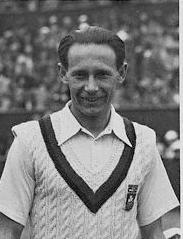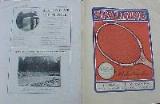
Annoucement of the French International Championship, 1926. |
The French Championship becomes international French translation
|
| 1924
was to be the last year that the French Championship was restricted to
players that were registered with clubs in France. It was in fact the closure
of another competing tournament, known as the “World” Clay Court Championships
in Saint-Cloud in 1923, that had started the debate to internationalise
the event. This tournament, held in the park at Saint-Cloud, had become
somewhat fashionable to the Parisians who took pleasure in turning out
to see the top overseas players each June. The debate was quickly decided
and the French Championship opened to all comers for the first time in
1925.
The last truly French Championship
of 1924 was held on the courts of Racing at the "Croix Catelan", in the
Bois de Boulogne.. As might be expected, the four French Musketeers met
in the semi-finals: Lacoste-Cochet and Borotra-Brugnon. Borotra was victorious
in the final against Lacoste, taking the match in five sets 7/5 6/4 0/6
5/7 6/2, with a formidable display of volley play. Jean Borotra went
on to take the triple crown this year, winning the men’s doubles with Lacoste
and the mixed doubles with Mademoiselle Billot. The absence of Suzanne
Lenglen through illness had made the latter of these tasks a little easier
than it might have been otherwise.
|

Jean Borotra |
| The first “International” French Championship of 1925 was held at the same site as the defunct World Clay Court Championships in the French Stadium in Saint-Cloud Park. The men’s final of the day was to be somewhat “déjà-vu”: Lacoste-Borotra. This time Lacoste was to emphatically take his revenge in three straight sets. Borotra-Lacoste also won again in the men’s doubles against Cochet-Brugnon. Happily, the international flavour of the rejuvenated event was marked by the Belgian Washer and the Hindou Jacob both reaching the men’s semi-finals. |
| In
1926 the Championship moved back to the courts at Racing and saw the return
of the Americans in the form of Richards and Kinsey. This year Cochet distinguished
himself in a final against Lacoste, taking the men’s singles title and
his first ever major trophy. He took particular pleasure in a semi-final
straight sets victory over the American Vincent Richards. Richards had
beaten him at the Olympic Games final two years before.
Kinsey and Richards were to take the men’s doubles title however in two thrilling successive victories over Borotra-Lacoste and then Cochet-Brugnon. In so doing, Richards was to be the first player to win the three grand slam doubles titles: Forest Hills(1918), Wimbledon (1924) and Paris. The less well-recognised Australian title was at this stage only competed for by players travelling to the southern hemisphere to take part in the Davis Cup. Richards was quite clearly one of the greatest men’s doubles players of all time, a fact proven by his innumerable victories with Williams in the Davis Cup. |

La Croix-Catelan in Boulogne Lacoste, Borotra, Kinsey et Richards before the double semi-final. |
|
Front page of the prgramm, 1926 |

Ad for Spalding
|
The
draw.

Lacoste is seeded N°1. |
Previous story : 1922-1926
The
French Musketeers and their conquest of the Davis Cup.
Next story : 1927,
France beats USA 3/2.
Dernière mise à jour : 02
April 2002
Copyright BLANCHE NET communications.
Mars 2000.